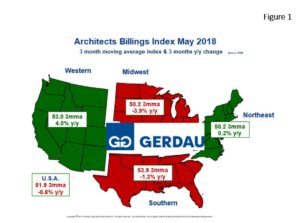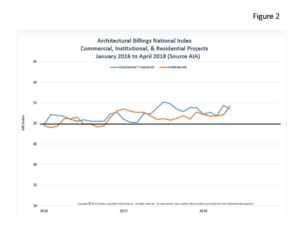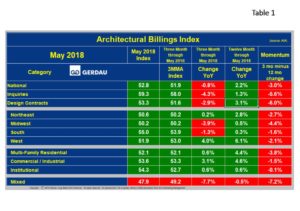Architectural Billings Index
May’s ABI national overall score of 52.8 was up 0.8 points from April’s 52.0 but still in the expansionary zone, (>50). U.S. architecture firms with emphasis on commercial and/or institutional specialization reported exceptional strong billings. Regionally activity was especially strong in the Southern region. The new projects inquiry index came in at 59.3, up 2.7 points from last month, while the new design contracts index increased 3.2 points to 53.3. Regional monthly scores were: South 55.0, West 51.9, Midwest 50.2 and Northeast 50.6.
The Architecture Billings Index (ABI), is a leading economic indicator that provides an approximately nine to twelve month glimpse into the future of nonresidential construction spending activity. The results are seasonally adjusted to allow for comparison to prior months. Scores above 50 indicate an aggregate increase in billings, and scores below 50 indicating a decline.
 Figure 1 presents a map of the U.S. depicting the four ABI regions. It is color coded to show expanding billings and increased growth in green and declining billings and negative growth in red. The data is shown on this map is as three month moving averages (3MMA), and 3 month year on year (y/y), percent change.
Figure 1 presents a map of the U.S. depicting the four ABI regions. It is color coded to show expanding billings and increased growth in green and declining billings and negative growth in red. The data is shown on this map is as three month moving averages (3MMA), and 3 month year on year (y/y), percent change.
On a 3MMA basis, the national ABI score was 51.9 with a decline of 0.8% y/y. The Southern region posted the highest 3MMA of 53.9 and a negative annual growth rate of 1.3%. The Western region’s 3MMA ABI was 53.0, with an annual growth rate of 4.0%. The Midwest zone scored a 50.2, 3MMA, its annual growth rate was -3.9% y/y. The Northeast recording an ABI of 50.2, 3MMA. Its annual growth rate was positive 0.2%
Figure 2  charts the ABI sub-index for Commercial / Industrial and Institutional from 2016 to present. The Commercial/Industrial sub-index decreased by 0.8 points month on month to 53.6 in May, still in the expansionary range. The Institutional sector is trending sharply upward, scoring a 54.3 in May, up 2.2 points m/m. May’s score marks a record high since July of 2015 where it registered at 55.3.
charts the ABI sub-index for Commercial / Industrial and Institutional from 2016 to present. The Commercial/Industrial sub-index decreased by 0.8 points month on month to 53.6 in May, still in the expansionary range. The Institutional sector is trending sharply upward, scoring a 54.3 in May, up 2.2 points m/m. May’s score marks a record high since July of 2015 where it registered at 55.3.
 Table 1 lists the overall ABI and all of its sub-indexes. It presents and compares monthly and 3MMA data, showing percentage point change on both three and 12 month basis, as well as momentum. Green denotes positive change, while red indicates negative growth. National momentum, (3 month y/y subtract 12 month y/y) was negative, at -3.0%. Momentum for all categories were negative for the month of May.
Table 1 lists the overall ABI and all of its sub-indexes. It presents and compares monthly and 3MMA data, showing percentage point change on both three and 12 month basis, as well as momentum. Green denotes positive change, while red indicates negative growth. National momentum, (3 month y/y subtract 12 month y/y) was negative, at -3.0%. Momentum for all categories were negative for the month of May.
In its release today, AIA Chief Economist, Kermit Baker, Hon. AIA, PhD, quoted the following: Architecture firms continue to have plenty of work as they enter the busiest part of the design and construction season, this is especially true for firms serving the institutional building sector, which reported their strongest growth in billings in several years.”
At Gerdau we follow the ABI because it is a leading indicator of non-residential construction activity with an approximate 12 month lead-time to ground-breaking. The ABI has a proven track record and as such it is useful for business planning purposes.

